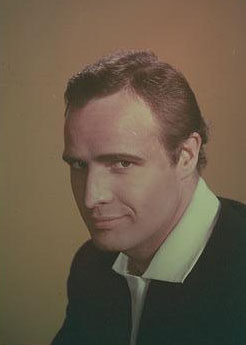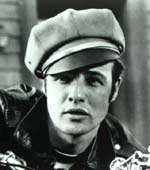Films with Brando
 THE MEN (1950)
THE MEN (1950)
For The Men, his first film, Method-trained Brando began developing his austere preparation techniques: He snubbed Hollywood, instead spending weeks in a wheelchair among hospitalized war vets in Van Nuys.
The Men begins eerily, with almost sleepwalking soldiers on patrol heading toward their doom. Suddenly, the platoon leader, Ken Wilozek (Brando), is cut down by a sniper and in an embittered voice-over. Brando mutters his first words on screen: "That's very, very funny. I was afraid I was going to die. Now I'm afraid I'm going to live." Waking up paralyzed and hospitalized, he's moody, sullen, petulant, proud, but also muscular and sexy (in T-shirt) and warm and sensitive ( if you can only break through to him). The Brando of the Movies is born. The nicest thing about The Men is its realistic portrayal of the camaraderie among the hospital ward patients; director Fred Zinnemann coaxes splendid performances from a pre-Dragnet, bearded, Emerson- quoting Jack Webb. However, everybody has to fight to stay above screenwriter Carl Foreman's sententious script, which includes gruff doctors delivering didactic speeches about the inner lives of wheelchair-bound patients.
A STREETCAR NAMED DESIRE (1951)
Brando's Academy Award-winning performance? Wrong. Hollywood went instead for Bogart's belching riverboat captain in The African Queen, although Streetcar's Vivien Leigh, Kim Hunter, and Karl Malden all got Oscars.
Brando's Stanley Kowalski is perhaps the greatest performance, on stage or in movies, of a male actor in the twentieth century. Transcendent drama: Kowalski stalking Blanche (Leigh), playing cards, belting down beer, parading about in his bathrobe, living in that almost breathing torn undershirt, screaming "STELLAAAA" by starlight. Lucky for us that Brando hitchhiked from New York to Tennessee Williams's summer home in Provincetown to convince the playwright that he was the perfect Kowalski.
VIVA ZAPATA! (1952)
 It's easy to read Elia Kazan's film as a God That Failed. Brando's Emilio Zapata is a peasant against revolutions and revolutionaries. A Lenin type who, after the overthrow of the czarlike General Diaz (Fay Roope), rejects the weak Kerenskyish leadership of Madero (Harold Gordon), murders the most Trotskylike of his own men (Lou Gilbert), is then assassinated by the Stalinist Fernando (Joe Wiseman). Thus, Kazan's revolution cynically circles around itself, ending up in totalitarianism. Filled with Eisensteinian (his brother) visual flourishes, Viva Zapata! looks great. Jean Peters, Howard Hughes's offstage woman, is gorgeous as Zapata's aristocratic love. And Brando? His intensity saves Zapata-but just-from parody. Written by John Steinbeck.
It's easy to read Elia Kazan's film as a God That Failed. Brando's Emilio Zapata is a peasant against revolutions and revolutionaries. A Lenin type who, after the overthrow of the czarlike General Diaz (Fay Roope), rejects the weak Kerenskyish leadership of Madero (Harold Gordon), murders the most Trotskylike of his own men (Lou Gilbert), is then assassinated by the Stalinist Fernando (Joe Wiseman). Thus, Kazan's revolution cynically circles around itself, ending up in totalitarianism. Filled with Eisensteinian (his brother) visual flourishes, Viva Zapata! looks great. Jean Peters, Howard Hughes's offstage woman, is gorgeous as Zapata's aristocratic love. And Brando? His intensity saves Zapata-but just-from parody. Written by John Steinbeck.
ON THE WATERFRONT (1954)
Brando's Academy Award? Right. He shocked Hollywood by playing along with the rules laughing along with host Bob Hope, accepting his Oscar with a gracious, cliche-ridden speech of gratitude. Sinatra was actually signed up to play the Waterfront's hero, Terry Malloy, but Brando some how insinuated himself with Elia Kazan and emerged with the coveted role. There are magnificent performances everywhere in this film, a triumph for the Actors' Studio; even the smallest parts are played by future actors of substance, such as Nehemiah Persoff and Fred Gwynne. But at the center of it all are Brando and Eva Marie Saint, who repeat the old Virginian saga of the inarticulate good-bad cowboy this time moved east to the docks of pre-Yuppie Hoboken, New Jersey. This is Brando's most touching and connected romance.
GUYS AND DOLLS (1955) As gambler Sky Masterson, Brando sings, and he's not bad in a breathy, amateurish way; he gets through "Your Eyes Are the Eyes of a Woman in Love" on pure charm. But when he has to belt out that immortal crapshooters' national anthem, "Luck Be a Lady," he can't cut it, and Guys and Dolls falls flat at what should be its musical and dramatic climax. No wonder Frank Sinatra, excruciatingly miscast as Jewish gambler Nathan Detroit, screamed and complained because he wasn't playing Brando's musically demanding role.
Brando redeems himself in a Batista-era. Havana nightclub, where Masterson has whisked off Salvation Army lass Sarah Brown (classy Jean Simmons). After drinking a lethal alcoholic potion, she turns tipsy and ribald, and leans into Brando's face for a night of love. It's hot stuff, but every- thing cools out when they return to New York. Guys and Dolls can be magic on stage, but the film misses the mark (for instance, Stubby Kaye's "Sit Down, You're Rockin' the Boat," a showstopper on Broadway, becomes a yawn when he sings it in the movie).This is it for Marlon Brando musicals. Directed by Joseph Mankiewicz.
ONE-EYED JACKS (1961)
Brando's first, and only, directorial effort deserves another look. Brando borrowed actors from John Ford (Ben Johnson, Hank Worden) and a directing style from Kazan, but he makes this Western distinctly his. Utilizing an exotic setting along the wave-beaten Mexican coast, he spins a primal Oedipal tale Rio ( Brando) is betrayed by "Dad" Longworth (Karl Malden), and gets revenge by seducing Longworth's overprotected stepdaughter (Pina Pellicer). One-Eyed Jacks is tight, well plotted, and suspenseful. Brando is as cool as Clint Eastwood, Ben Johnson is grand as a grubby, blackguard bank robber, and Malden steals the film.
THE CHASE (1966)
Auther Penn GREAT AS Brando as a sheriff beaten up by the townsmen.Robert Redford, Jane Fonda,Robert Duvall, Angie Dickinson
REFLECTIONS IN A GOLDEN EYE (1967)
Another underrated work. Slightly mordant and malodorous it is an extraordinarily faithful adaptation by John Huston of Carson McCullers's short novel about stultifying, sicko life on a Southern military base. Did Edward Albee base Virginia Woolfs imbalanced Martha and George on Weldon and Leonora Penderton, McCullers's weird, introverted couple? Brando is perfect as Major Penderton, a rigid, anal military scientist who - impotent with his loud mouthed, flashy Southern belle of a wife (played with real bravado by Elizabeth Taylor) slowly discovers his buried homosexuality. Brando lifts weights, talks to his image in the mirror, contemplates a secret picture of a Michelangelo male nude, and, in an inspired moment not in McCullers's novel, pats down his fading hair and lies back in bed in anticipation of a soldier boy sneaking up to his boudoir. Sorry, but the soldier is there to stare at sleeping Liz in the next room which sets up Reflections' final, tragic moment, and explains McCullers's famous first-page line: "There is a fort in the South where a few years ago a murder was committed."
BURN! (1970)
The most undervalued Brando film of all. This is Viva Zapata! from the left; Gillo Pontecorvo's (The Battle of Algiers) sweeping, monumental epic of revolution is the most coherent, articulate dramatization of Marxist political dynamics in the history of cinema after Eisenstein. Brando plays ultravillainagent provocateur William Walker, who keeps stirring up revolutions on the island of Queimada until the place has fallen apart-and Walker's colonialist interests can take over forever. But Walker doesn't realize that the wretched of the earth are merely waiting for the right moment to strike again. For the black revolutionary leader Jose Dolores, Pontecorvo chose Evaristo Marquez, an illiterate islander who had never before seen a movie or a movie camera. As Marquez gains confidence and ability in acting and you can see his advances on the screen so, too, does he swell into a magnificent political leader. Where is Pontecorvo today, almost two decades since Burn? His absence is a tragedy for the cinema.
THE GODFATHER (1972)
What can be said anew about Brando's deservedly heralded "comeback" as the man who makes an offer you can't refuse? Brando's Vito Corleone is an Elizabethan king, smarter and foxier by far than his legion of foot soldiers and acolytes. Acting students, start your lessons here: Everything you need to know is in Brando's first fifteen minutes on screen.
LAST TANGO IN PARIS (1972)
Bernardo Bertolucci's dramatization of love with an improper stranger is electric every time Brando and Maria Schneider touch the screne. But back in the empty apartment, sexy things happen. They make love, and more love, play the harmonica, sing "The Good Ship Lollipop," cook and make love until Maria Schneider shoots Brando dead. Brando is killed by sex and by love Marlon Brando is dead: long live Marlon Brando. "
"Why don't you go back to America?" Maria Schneider asks Marlon Brando in Last Tango in Paris. "I don't know," he answers, enigmatically, despondently. "Bad memories, I guess." Whatever the reason, we have lost him. Come back to Hollywood and Vine, Marlon Brando, Marlon Brando.
APOCALYPSE NOW (1979)
Well he came back in two films i enjoyed. As Kurtz in Apocalypse Now, spouting incoherent mumbojumbo in Cambodia?
The Freshmen (1990)
Brando has come back to Hollywood and Vine, with a sense of humor. A film student picking up a package for an enigmatic "importer"--played by the great Marlon Brando in a virtual reprise of his Godfather role. Can the student juggle Brando's embrace and romance with his daughter? Marlon Brando , Matthew Broderick, Penelope Ann Miller, Maximilian Schell, Bruno Kirby 